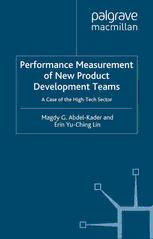Table Of ContentPerformance Measurement of New Product Development
Teams
Also by Magdy Abdel-Kader
ENTERPRISE RESOURCE PLANNING
Implementation and Management Accounting Change in a Transitional
Country(with A. Kholeif and M. Sherer)
BEHAVIOURAL ASPECTS OF AUDITORS’ EVIDENCE EVALUATION
(with M. Abou-Seada)
INVESTMENT DECISIONS IN ADVANCED MANUFACTURING TECHNOLOGY
A Fuzzy Set Theory Approach (with D. Dugdale and P. Taylor)
NON-FINANCIAL PERFORMANCE MEASUREMENT AND MANAGEMENT
PRACTICES IN MANUFACTURING FIRMS
A Comparative International Analysis(with A. Abdel-Maksoud)
Performance Measurement of
New Product Development
Teams
A Case of the High-Tech Sector
Magdy G. Abdel-Kader
Senior Lecturer, Brunel Business School, Brunel University, UK.
and
Erin Yu-Ching Lin
PricewaterhouseCoopers, Taipei, Taiwan
© Magdy G. Abdel-Kader and Erin Yu-Ching Lin 2009
All rights reserved. No reproduction, copy or transmission of this
publication may be made without written permission.
No portion of this publication may be reproduced, copied or transmitted
save with written permission or in accordance with the provisions of the
Copyright, Designs and Patents Act 1988, or under the terms of any licence
permitting limited copying issued by the Copyright Licensing Agency,
Saffron House, 6-10 Kirby Street, London EC1N 8TS.
Any person who does any unauthorized act in relation to this publication
may be liable to criminal prosecution and civil claims for damages.
The authors have asserted their rights to be identified
as the authors of this work in accordance with the Copyright, Designs
and Patents Act 1988.
First published 2009 by
PALGRAVE MACMILLAN
Palgrave Macmillan in the UK is an imprint of Macmillan Publishers Limited,
registered in England, company number785998, of Houndmills, Basingstoke,
Hampshire RG21 6XS.
Palgrave Macmillan in the US is a division of St Martin’s Press LLC,
175 Fifth Avenue, New York, NY 10010.
Palgrave Macmillan is the global academic imprint of the above companies
and has companies and representatives throughout the world.
Palgrave® and Macmillan® are registered trademarks in the United States,
the United Kingdom, Europe and other countries.
ISBN 978-1-349-36485-5 ISBN 978-0-230-58427-3 (eBook)
DOI 10.1057/9780230584273
This book is printed on paper suitable for recycling and made from fully
managed and sustained forest sources. Logging, pulping and manufacturing
processes are expected to conform to the environmental regulations of the
country of origin.
A catalogue record for this book is available from the British Library.
A catalogue record for this book is available from the Library of Congress.
10 9 8 7 6 5 4 3 2 1
18 17 16 15 14 13 12 11 10 09
This book is dedicated to our families …
Magda Abou-Seada and Mohamed Abdel-Kader … (MAK)
My father, My mother and My two younger brothers
and their wives … (EYL)
This page intentionally left blank
Contents
List of Tables xi
List of Figures xii
List of Abbreviations xiv
Preface xvi
Chapter 1 Introduction 1
1.0 Introduction 1
1.1 Background to the study 2
1.2 High-technology industry in Taiwan 4
1.2.1 Key definitions of high-technology industry 6
1.2.2 Distinctiveness of new products 7
1.3 The role of management accounting and management 9
accountants
1.4 The gap between theory and practice in management 11
accounting
1.5 Objective and research questions 12
1.6 Significance of the study 15
1.7 Conclusion and book structure 17
Chapter 2 New Product Development Success Factors 20
2.0 Introduction 20
2.1 Overview of new product development research 20
2.2 New product innovation: past evidence and present 22
application
2.2.1 Key definitions of new product success/failure 26
2.2.2 New products: key success factors versus failure 28
factors
2.2.3 New product development processes and project 33
teams
2.2.4 External business environment and organisation 37
2.3 Conclusion 41
vii
viii Contents
Chapter 3 The Organisational Architecture 42
3.0 Introduction 42
3.1 Assignment of decision rights 42
3.1.1 Authority versus responsibility 43
3.1.2 Formation and integration of project team 47
3.2 Reward and punishment system 52
3.2.1 The role of incentive and motivation 52
3.2.2 Teamwork environment: incentive versus 55
performance
3.3 Performance measurement system 56
3.3.1 Why – Needs of performance measurement 57
3.3.2 What – Areas of performance measurement 61
3.3.3 How – Use and impact of measurement results 62
3.4 Conclusion 71
Chapter 4 Conceptual Framework 73
4.0 Introduction 73
4.1 The economic approach – agency theory 73
4.2 Sociological and psychological approaches 77
4.2.1 Stewardship theory 78
4.2.2 Social identity theory and self-categorisation 79
theory
4.3 Why multiple theories are used in the conceptual 82
framework
4.4 The conceptual framework 83
4.4.1 Incentive – team effort – effectiveness 83
4.4.2 Incentive – performance 86
4.4.3 Incentive – effort – performance – success 88
4.5 Conclusion 93
Chapter 5 Research Methodology and Methods 94
5.0 Introduction 94
5.1 Alternative paradigms 94
5.1.1 Ontological assumptions 96
5.1.2 Epistemological assumptions 98
5.1.3 Methodological assumptions 99
5.2 Case study research 100
5.2.1 Advantages of case study 103
5.2.2 Limitations of case study 104
5.2.3 Validity and reliability 104
5.2.4 Selection of sample cases 106
Contents ix
5.3 Multiple-case study design 107
5.4 Data collection methods 109
5.4.1 The primary method – interviews 111
5.4.1.1 Procedures of interviews 111
5.4.2 The secondary method – documentation 114
5.5 Data management 115
5.5.1 Management of documents 116
5.5.2 Management of interviews 118
5.5.3 Data storage and retrieval 119
5.5.4 Content analysis method 121
5.5.5 Analytic induction 122
5.6 Conclusion 122
Chapter 6 Case Study and Interpretation 124
6.0 Introduction 124
6.1 Themes and the code 124
6.2 Within-case analysis 127
6.2.1 Case A 127
6.2.2 Case B 140
6.2.3 Case C 152
6.2.4 Case D 159
6.3 Conclusion 168
Chapter 7 Cross Case-Studies Analysis 170
7.0 Introduction 170
7.1 Internal and external factors 170
7.2 The organisational architecture 172
7.3 Agents or stewards? 176
7.4 The level of self-categorisation and team identification 178
7.5 Developing an empirical framework 180
7.6 Conclusion 185
Chapter 8 Discussion 187
8.0 Introduction 187
8.1 Validity and reliability 187
8.2 The role of management accounting and management 191
accountants
8.3 Agents versus stewards 196
8.4 The gap between theory and practice in management 201
accounting
8.5 Conclusion 210

